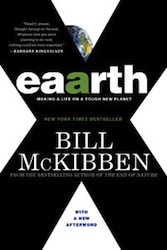What is happening to the “Eaarth”? A question many are asking, including author Bill McKibben, as the summer brought us the worst drought in decades along with extreme heat. Many people would blame this on global climate change while others would argue that “global warming” and “weather” are actually two separate things. Well it is time we delve back into the discussion I began earlier this summer as part of my 2012 La Nina Reading List.
McKibben is a true believer in climate change, holds humans responsible and writes we’re dealing with a “spooky, erratic  climate”. He writes that global warming is no longer a philosophical threat or a future threat, no longer a threat at all. It is reality. Because we no longer live on the same planet, argues McKibben, earth needs a new name: Eaarth.
climate”. He writes that global warming is no longer a philosophical threat or a future threat, no longer a threat at all. It is reality. Because we no longer live on the same planet, argues McKibben, earth needs a new name: Eaarth.
The focus of his book is to turn back time, per se, to safe levels of carbon dioxide in the atmosphere. The “safe” level according to climatologist James Hansen, is 350 parts per million – a number we have surpassed and now hover around 390 parts per million. Throughout the book, Hansen explains why lowering levels of CO2 “will be extremely hard” but offers ways “we can try”.
Why do we need to do this? Because, argues McKibben, “…the earth has changed in profound ways, ways have already taken us out of the sweet spot where humans so long thrived. We’re every day less the oasis and more the desert. The world hasn’t ended, but the world as we know it has- even if we don’t quite know it yet.”
One of the main issues he focuses on in the book is the need to replace the fossil fuel system. Other issues include the need to fix infrastructure and he posits that climate change will cause more resource wars and leave billions of people “climate change refugees”.
The book concludes with a discussion about ways to reduce impact with the main theme being things need to get smaller and less centralized. He also writes that we need to focus on maintenance not growth. In addition, McKibben writes we need global governments to have the courage to take a stand against climate change.
For those who are passionate about the environment, you know that McKibben is one of the best-known writers in the field. His latest book doesn’t disappoint – it is an interesting read. Yet he barely scratched the surface on outlining what needs to be done to live on the new Eaarth. Might that be the topic is his next book that he could call Eaarth 2.0?

